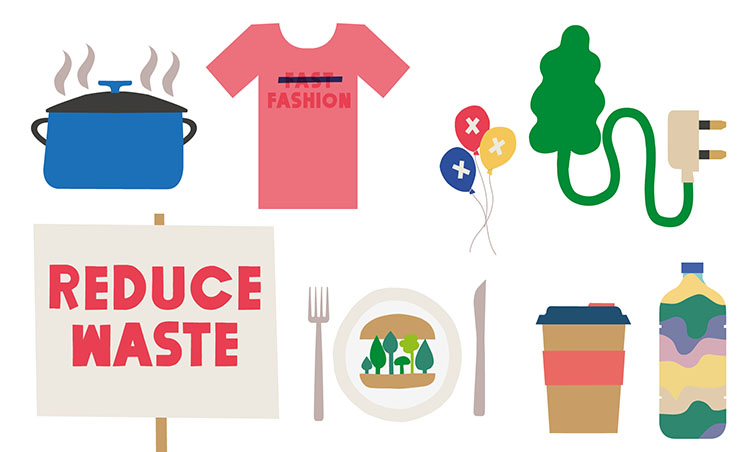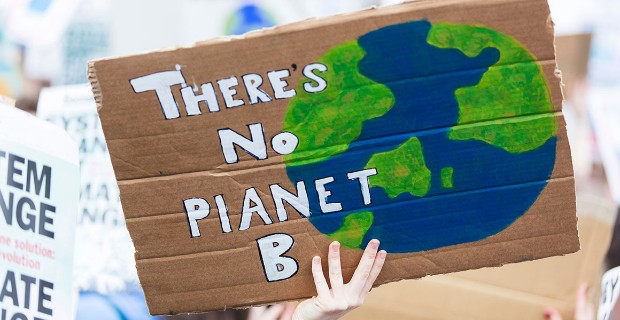In this activity, your class watches short clips of Greta Thunberg and Museum scientists answering questions from young people about the climate crisis. You can then challenge your students to consider their own opinions and actions.
Topics covered include: Interconnectivity, Biodiversity, Climate Crisis, Possible Solutions, Climate Justice, Eco Anxiety and COP 27.
- Key Stage: KS2(yr6), KS3, KS4
- Time required: 15 minutes - 1 hour+
About this resource
- Resource type: classroom activity, video, discussion
- Theme: Climate change and biodiversity
Overview
Greta Thunberg visited the Natural History Museum in 2022 and met students from London schools. They spoke together and with Museum scientists about biodiversity, the climate crisis and eco anxiety and possible solutions to these problems. The event was produced in partnership with Penguin Books, publishers of The Climate Book.
This resource presents snippets from the discussion and challenges your students to listen, reflect and discuss their own thoughts on the subject. The resource contains short video clips and suggested conversation starters which can be used in various ways as part of lessons.
- Warm up: Interconnectivity
- Biodiversity (linking to KS3 and KS4 National Curriculum)
- Climate Crisis
- Possible Solutions
- Climate Justice (recommended for advanced groups)
- Eco Anxiety (highly recommended for all)
- COP 27
Teachers can select themes that are most relevant to their lessons however we recommend covering ‘Eco Anxiety’ alongside any other topic.
Teacher notes with supplementary information and suggestions can be found below.
This is the full 60 minute video of Greta Thunberg in conversation at the Museum. Short clips are below.
Warm up: Interconnectivity
suggested time 5-10 mins
Conversation starter: Are humans’ part of nature? Why/why not?
Biodiversity
suggested time 20-30 mins
1. Biodiversity is the variety of life on Earth - everything from bacteria to seaweed to people. You can watch this video as a reminder of ‘What is Biodiversity?’
2. Provide the below five questions to your students as discussion points or a written task (to answer after watching the clip below):
- What is biodiversity?
- What does biodiversity mean to you?
- How might your life be different with less biodiversity in the world?
- Give an example of interconnectedness in nature.
- How is biodiversity loss and the climate crisis linked?
3. Watch the video clip below:
4. Provide time for students to reflect on/write answers to the five questions. Then discuss answers in small groups or as a class.
5. Watch one of these additional videos to show more examples of interconnectedness in nature:
- How flies help make your chocolate ice cream
- How piranha poop helps make your trainers
- How fish scales make your make-up shimmer
Climate Crisis
suggested time 20-30 mins
1. Conversation starter: What do you think is the worst-case scenario of the planetary crisis for humans?
2. Watch the video clip below:
3. Conversation starter: What solutions to the climate crisis and biodiversity loss have you heard of before in terms of:
- Individuals?
- Local?
- Political?
- International?
4. Watch the video clip below:
5. Conversation starter: Imagine a company, government or individual who does NOT already take part in any of the solutions. What do you think it would take to convince them?
Possible solutions
suggested time 30 - 40 mins
1. Student reflection/recap: Take a moment to consider the different things that individuals and societies can do to help reduce biodiversity loss and climate change. (If you completed the previous topic ‘Climate Crisis’, remind the students of some of the solutions you spoke about.)
2. Watch the video clip below:
4. Recap some solutions as to how individuals can choose to help protect the planet (click through the carousel of images below, or you can view the whole article here):
5. Watch the video clip below:
6. Conversation starter: What are your opinions on protests?
7. Follow up question: Are there any other types of smaller/simpler protests than taking to the streets? What different types of protests can you think of?
8. Watch the video clip below:
9. Conversation starter: Do you think companies and governments do enough to protect the planet?
10. Watch the video clip below:
- Conversation starter: Do you think there should be any consequences for people or countries who damage the environment the most?
Climate Justice
suggested time 15 - 20 mins. This topic is recommended for more advanced students.
1. Conversation starter: The planetary emergency does not and will not affect people equally across the world. In what ways do you think it might affect some people more than others?
2. Watch the video clip below:
3. Conversation starter: How do you feel about living in a relatively protected country that contributes heavily to the planetary emergency, whilst other countries contribute less but feel the affects more?
Eco Anxiety
suggested time 15 - 30 mins
1. Conversation starter: How do you each feel about the state of the planet?
2. Watch the video clip below:
3. Conversation starter: Do you feel like you have the power to change things?
4. Watch the video clip below:
5. It is very common for people to feel anxious about the planetary crisis. Here are some things to remember if you start to feel overwhelmed:
- Remind yourself that caring about the planet and your future the right thing to do. It is something worth caring about. Having worrying feelings about it is justified and common.
- Turn anxiety into action – this can help you feel less helpless and more in control. Pause when you need too, keep going when you are able.
- These are long term problems, so the solutions will be long term solutions. It will take a long time to see positive outcomes. Come back to the present moment and think about what you can control right now.
- It is easy to feel that in such a big problem, there is nothing you can do that would make a difference but remember: 'We don't need a handful of people doing (it) perfectly. We need millions of people doing it imperfectly.'
- Do what you can – not everyone is able to take on board all solutions. Don’t feel ashamed if you cannot join in with certain solutions.
- Remember, choices become habits. Start with one small positive choice and it might become automatic habit over time.
- Talk about the changes you make, the good and bad bits – this can help you feel more in control of the situation and might inspire others to get involved too.
- Get outside! Nature can have a positive impact on wellbeing.
- Support to each other’s efforts. We are all in this together. Inside classrooms, homes and across the globe. Notice and encourage other people’s positive actions.
COP 27
suggested time 10 - 15 mins
1. Conversation starter: Have you heard of COP before? What do you understand about it?
2. Watch the video clip below:
3. Conversation starter: In a meeting of global leaders – what priorities do you think different countries might have? What would you hope would be at the top of the agenda for them to discuss?












